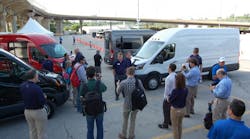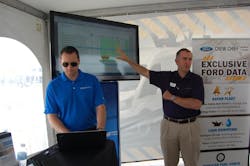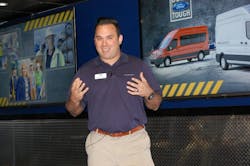So I spent a few days this week with a gaggle of other journalists test driving Ford Motor Co.’s new 2015 Transit full-size van out in Kansas City, MO: which is coincidentally home to the production plant where Ford builds the new Transit as well as its F-150 pickup.
[To view more photos of the Transit “ride and drive” event, click here. If you want to see how the Transit gets built at Ford’s “KCAP” factory, go here.]One of the more interesting things about Ford’s test drive event, though, is how it reflects the big changes going on in the commercial van space – vehicles that Ford, for one, believes makes up 20% of the Class 1-7 global commercial vehicle market as a whole.
Indeed, vans are no longer an afterthought in the commercial market – a subject I touched on in more detail in this story last year – and as a result OEMs are trying to build more capability into the van than ever before, which includes equipping them with the same high-grade technological packages pickups and big rigs get – packages that not only provide navigation but fuel consumption and maintenance data as well.
At the Transit event, Bill Frykman, product and business development manager for Ford’s Work Solutions arm, noted that the vans will be equipped with the OEM’s Crew Chief technology package – a system powered by Telogis – allowing van fleets to tap into vehicle diagnostics, location and driver behavior data.“Driver behavior has so much influence on not only fuel efficiency but on the overall maintenance and life of a vehicle,” Frykman (seen at far right in photo at left) noted, adding that according to U.S. Department of Energy data, aggressive driving decreases fuel economy by up to 33%.
But it’s more than using data to try and get van drivers to reduce engine idling, speeding, etc., Frykman told me.
“Ten years ago we had maybe 10 ECMs [electronic control modules] on such commercial vehicles,” he explained.
“Now we’ve got well over 60 in some cases, producing all kinds of valuable data fleets can tap into to make their operations more efficient,” Frykman said.
For example, Crew Chief can monitor engine oil life, diagnostic trouble codes, and a host of other data streams to help van fleets – like their pickup, medium-duty, and heavy-duty counterparts – fine-tune their maintenance schedules in order to reduce unnecessary downtime.
Frykman stressed, too, that all this information is in the fleet’s hands, not those of Ford or Telogis. If fleets want to activate the system and tap into it, great; if not, then it won’t get activated.
The savings, though, are hard to ignore – especially since, Crew Chief is a factory-installed product, there’s no extra aftermarket downtime and it gets covered under the OEM’s 3 year, 100,000 mile warranty.
For example, Crew Chief data determined that one of the shuttle buses serving the Transit event burned 15 gallons of diesel over two days at idle – roughly $60 worth of fuel spent going nowhere. While that might not seem like a lot, extrapolated across a fleet of 20 or more vans for several weeks would make such fuel wastage extremely costly. Thus having such information at a fleet’s fingertips can help the operation reduce – if not eliminate – such unnecessary expenses.Anthony Piazza (seen at right), Ford’s assistant marketing manager for Transit, Transit Connect, and E-Series, told me that it’s those kinds of savings the OEM is trying to help customers achieve with its new Transit van – even if in some cases it results in the customers being able to shrink the size of their fleet in the process.
For example, he noted that the new Transit gets vastly better fuel economy compared to the E-Series it is replacing – while adding nearly 600 lbs. more worth of cargo carrying capacity. “Then you add in the data from Crew Chief and maybe you figure out you can replace two of your old E-Series van with one Transit,” Piazza said.
And while initially that would seem like a bad deal for Ford – replacing two vehicles with just one new model – Piazza stressed that it’s an example of why the OEM is focusing, in his word, on “the long term play.”
“As competitive as this industry is, at the end of the day, it’s all about customer retention,” he told me. “It’s all about getting that customer to come back to you for their next vehicle, their maintenance service, or whatever their needs might be.”
In Piazza’s view, that’s why trying to improve the return on investment or “ROI” calculation for vans like the Transit is important. “It just becomes a win-win for everyone,” he said.






